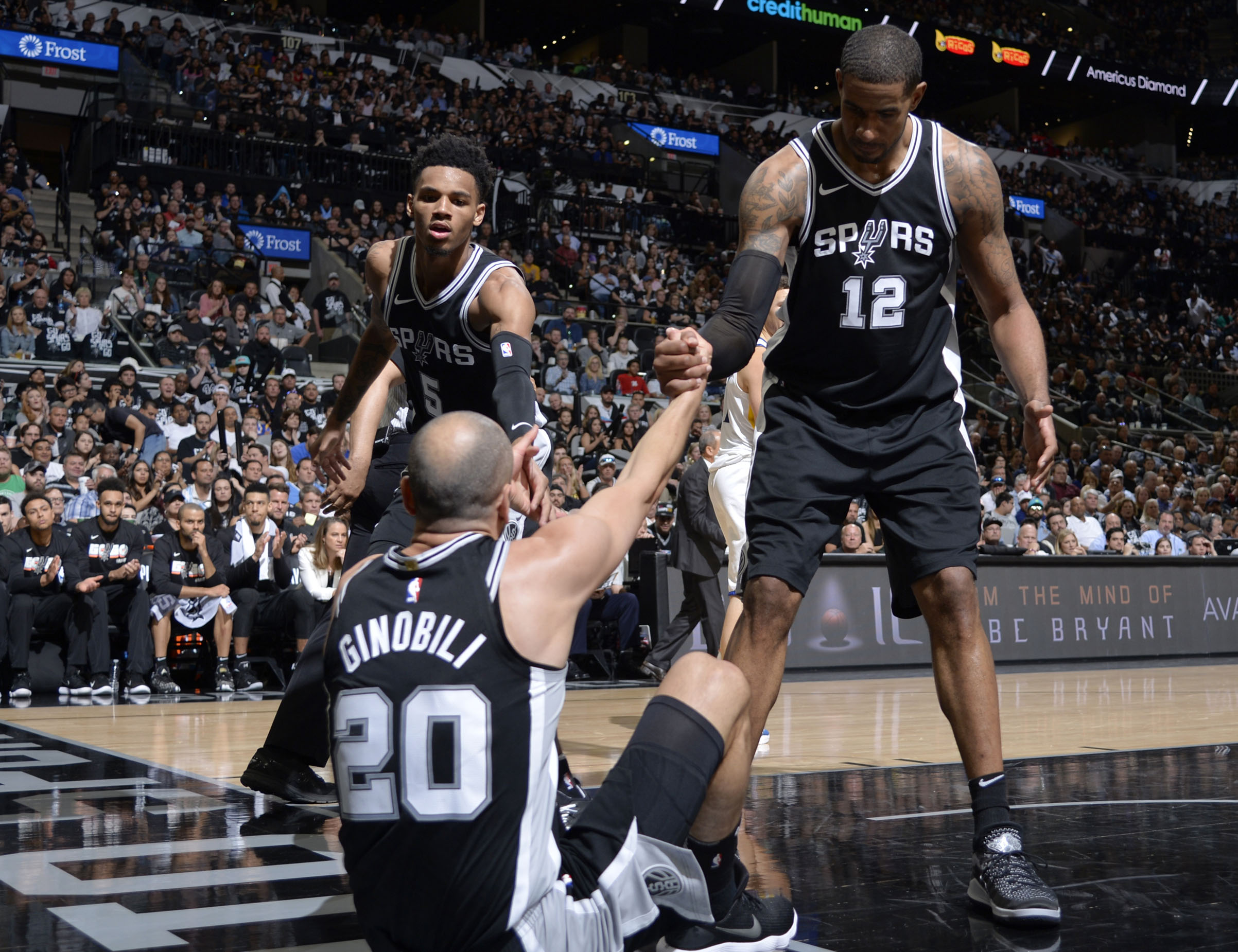Can Dejounte Murray Lead the Spurs Into a New Era?

It’s been a summer of change down in San Antonio. Kawhi Leonard pouted his way to Canada, Tony Parker is looking for a way to extend his career in Charlotte, and Manu Ginobili is on his way to retirement, hopefully downing espresso somewhere with Boris Diaw.
The Spurs’ roster as currently constructed is jarring to behold, littered with new additions and without a defined superstar. Patty Mills is the lone player with over five years of service in San Antonio, and five players enter 2018–19 in their first season with the Spurs. That increases to six if you count Marco Belinelli, who returns to San Antonio after playing for the Spurs from 2013–15.
DeMar DeRozan should fill the void left by the aforementioned trio to a degree. He displayed a stronger playmaking feel last season, bumping his assist rate to a career-high 25% in 2017–18. But the Spurs still find themselves with a dearth of quality creators. Patty Mills is more of a catch-and-shoot combo guard, and don’t expect LaMarcus Aldridge to sling passes from the block. The Spurs project to be miles away from their beautiful-game style of 2014, instead forced grind out possessions and win from the midrange.
Could the NBA Force J.R. Smith to Cover Up His Supreme Tattoo?
There may be one in-house antidote to the Spurs’ offensive issues, though, third-year point guard Dejounte Murray. The Washington product jumped to 21.5 minutes per game last season after appearing in just 38 contests during his rookie year, and now he could very well be given the keys to Gregg Popovich's attack.
There’s no questioning Murray’s defensive credentials. He earned his way into the Spurs rotation last year with wingspan that would make Jay Bilas drool and the closing speed of a top-flight cornerback. Murray trailed only Russell Westbrook in rebound percentage among guards last season while ranking fifth in steals per 36 minutes. He consistently shielded Parker and Mills by guarding opposing team’s top scorers, and often fared quite well. Murray held Westbrook to 22 points on 9–22 shooting while logging a season-high 39 minutes on Dec. 3, and clamped Jimmy Butler down to 2–13 from the field on Nov 15. The 21 year old wasn’t shaken by a pair of perennial All-Stars.

Murray’s defensive prowess earned him a spot on the 2017–18 All-Defensive second team. At 21, Murray became the youngest player in NBA history to make an All-Defensive squad, beating out Kobe Bryant, Tim Duncan and Anthony Davis. Only two other players in NBA history have reached an All-Defensive team in their first two seasons (Dwyane Wade and Patrick Beverley) making the 2016 first-round pick one of the most accomplished defenders through two seasons in league history.
But despite his impressive defensive chops, Murray has been limited thus far in his career by a subpar jump shot. He ranked last out of all guards with at least 20 minutes per game in three point attempts last season, registering just 0.4 per game. He wasn’t very effective when he let them fly, either, making 26.5% of attempts. Murray registered an effective field goal percentage of 45% last season, continuing shooting splits similar to his lone season at Washington. Murray made just 45.7% of two-point attempts with the Huskies, adding a 66.3% free throw percentage. His jumper isn’t Michael Kidd-Gilchrist-level broken, but Murray is a shaky enough shooter to stall the Spurs’ machine.
Murray has worked with legendary shooting coach Chip Engelland this offseason, aiming to rework his jumper from poor to passable. And if Murray can turn into a respectable shooter—and avoid defenses sagging off him a la Rajon Rondo—it will unlock the more impressive aspects of his game. Murray’s ascent could mirror Parker’s if he can evolve from an early career non-shooter to a legitimate threat and build range as he grows in San Antonio.
The pair share a similar teardrop floater, too, one perfected by Parker over the decades and employed increasingly by Murray as 2017–18 progressed. He isn’t one to absorb significant contact at a slim 170 pounds, but his soft touch near the tin has allowed him to be effective over the outstretched limbs of forwards and centers. Murray hit 50.6% of shots within 10 feet last season, which ticks up to 58.9% at the rim.
Is Kawhi Leonard Still a Top-10 Player in the NBA?
Murray has shown a quality offensive skill set outside of his poor jump shot. He’s an impressive leaper and shifty near the basket, contorting his thin frame around larger defenders. Few guards accelerate as quickly on the pick-and-roll, and while his instincts and nuance are still being developed, Murray has already fit in with San Antonio as a heady passer, especially in transition. He projects to be an ideal Popovich guard on both ends of the floor.
Entering his third season, Murray is far from a seasoned product. He’s prone to prolonged shooting slumps, and there will surely be occasions when Popovich wishes a veteran like Parker was heading the Spurs’ offense. Yet Murray’s ability through two seasons should thrill the San Antonio faithful, with another late first-rounder showing the promise of a potential building block. Murray will make his money as a defensive ace, but expect a significant leap on the other end of the floor in year three. Murray is quick with his head and feet, and will continue to evolve his shooting form. He won’t be the next Kawhi, but Murray should become another homegrown member of the Spurs’ core for years to come.
